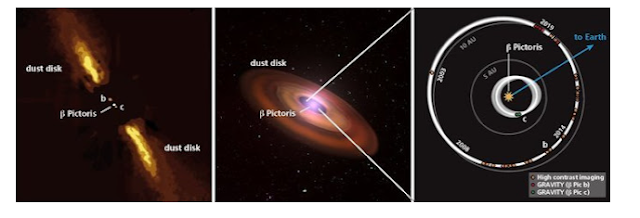The planet, known as "b Pictoris c," is situated in the Beta Pictoris system approximately 63 light-years away from Earth. They are trying to determine how it originated by using the additional brightness and dynamic mass data that came from imaging it.
By analysing the effect the planet had on the parent star's orbit, scientists were able to determine the planet's existence. It is impossible to imagine the planet alone because of how closely it orbits its star. Using information from the four telescopes of the VLT, the team was able to determine the location with extraordinary clarity and capture a photo of it. This was the first exoplanet that could be confirmed using both direct imaging and the "radial velocity technique."
Beta Pictoris b and the recently imaged Beta Pictoris c.
This indicates we can now determine both the brightness and the mass of this exoplanet, according to Mathias Nowak, the lead author of the paper that was recently published in the journal Astronomy and Astrophysics. Generally speaking, a planet's brightness increases with size.
To determine the mass, the researchers must wait until there is sufficient radial velocity data. This could take some time because of the exoplanet's 28-year orbital period. It is amazing the level of precision and sensitivity we can achieve with GRAVITY, according to Frank Eisenhauer, the GRAVITY project's chief scientist at the Max Planck Institutes for Astronomy and Extraterrestrial Physics.






0 Comments